Sensory Analysis of a New Citrus Juice made from 'Aliza' Fruit: A New Pomelo x Mandarin Hybrid
Article Information
Hagar Pardo1,5, Abiola Owoyemi1, Ofir Benjamin2, Livnat Goldenberg3, Yossi Yaniv3, Adi Doron-Faigenboim4, Nir Carmi3, Ron Porat1*
1Department of Postharvest Science of Fresh Produce, ARO, The Volcani Center, Rishon LeZion, Israel
2Department of Food Science, Tel Hai College, Upper Galilee, Israel
3Department of Fruit Tree Sciences, ARO, The Volcani Center, Rishon LeZion, Israel
4Department of Genomics and Bioinformatics, ARO, The Volcani Center, Rishon LeZion, Israel
5The Robert H Smith Faculty of Agricultural, Food and Environmental Quality Sciences, The Hebrew University of Jerusalem, Rehovot, Israel
*Corresponding Author: Ron Porat, ARO, The Volcani Center, P.O. Box 15159, Rishon LeZion 7505101, Israel
Received: 22 December 2020; Accepted: 06 January 2021; Published: 08 January 2021
Citation: Hagar Pardo, Abiola Owoyemi, Ofir Benjamin, Livnat Goldenberg, Yossi Yaniv, Adi Doron-Faigenboim, Nir Carmi, Ron Porat. Sensory Analysis of a New Citrus Juice made from Aliza Fruit: A New Pomelo x Mandarin Hybrid. Journal of Food Science and Nutrition Research 4 (2021): 001-011.
Share at FacebookAbstract
The sensory qualities of the juice of 'Aliza', a new pomelo × mandarin hybrid developed by the Israeli citrus breeding program, ARO, The Volcani Center, were analyzed and compared with orange and red grapefruit juices, whom are the most consumed citrus juices worldwide. The conducted sensory analysis of fresh 'Aliza', orange and red-grapefruit juices included flavor-description tests, consumer-acceptance tests, preference tests and evaluations by an electronic tongue (e-tongue) and an electronic nose (e-nose). The flavor of 'Aliza' juice is characterized by high sweetness, moderate sourness and bitterness, and strong citrusy and tropical fruity aromas. 'Aliza' juice is bitterer than orange juice and has less of a citrusy odor, but a stronger tropical odor. It is less sour and bitter than grapefruit juice and has a stronger tropical aroma. 'Aliza' fruit have a very high juice content, and its juice achieved the highest consumer-acceptability score among all of the examined citrus juices and was most preferred by the majority of all tasters. Objective taste-profile evaluations by the e-tongue revealed significant differences in sourness, bitterness and umami tastes among 'Aliza', orange and grapefruit juices. We conclude that 'Aliza' juice is different from orange juice and grapefruit juice and is highly preferred by consumers, and thus 'Aliza' fruit may be used for the development of a new preferred citrus beverage.
Keywords
Citrus, Flavours, Electronic tongue, Electronic nose
Citrus articles; Flavours articles; Electronic tongue articles; Electronic nose articles
Article Details
1. Introduction
Citrus juices are greatly appreciated due to their unique fresh and delicate flavour and high nutritional quality [1]. Orange juice is by far the most consumed citrus juice worldwide, followed by grapefruit juice. According to the Statista business data platform, in 2019, global orange juice production stood at 8,679 million L and brought in a total revenue of 29.7 billion US dollars [2]. Grapefruit juice production was 2.3 million L that year and brought in a total revenue of 4.3 billion US dollars [3]. The average per capita consumption of orange juice is 1.2 L per year and the average per capita consumption of grapefruit juice is 0.3 L per year globally [2, 3]. From the nutritional aspect, citrus juices are an important source of essential vitamins, pectin and soluble fibers, minerals, carotenoids and phytonutrients including flavonoids, phenols and limonoids. All of these substances play important roles in maintaining health and preventing degenerative diseases [4, 5].
Above all, citrus fruit and citrus juices are appreciated and consumed by billions of people around the globe because of their unique delicate and attractive flavours, evolved from a blend of sweet, sour and bitter tastes and fruity, fresh and earthy aromas [6]. Orange juice has a popular sweet-sour taste, as it contains about 11-12% total soluble solids (TSS) and has a titratable acidity (TA) rate of 1.0-1.2%, resulting in a TSS: TA ratio of ~10, and is considered non-bitter. The main aroma attributes of oranges are fruity, citrusy, herbaceous, spicy and floral notes [7, 8]. In contrast, grapefruit juice is less sweet and more sour, with about 10-11% TSS and 1.4-1.8% TA, resulting in a lower TSS:TA ratio of ~6.6 [9]. In addition, grapefruit accumulates the glycosidic-flavanone naringin that is responsible for imparting a bitter taste [10]. The main aroma attributes of grapefruit are fruity, green/grassy, terpene-like, pungent, citrusy, sulfurous/catty and grapefruit-like notes [11, 12].
'Aliza' is a new and unique pomelo × mandarin hybrid developed by the Israeli citrus breeding program at the ARO Volcani Center (Israel Patent ID: 3099). 'Aliza' fruits are about the same size as grapefruits, have a unique yellowish/golden color, are seedless and have a very high juice content (Figure 1). 'Aliza' fruits also have a unique flavour, which is a result of the combination of high sweetness, moderate bitterness and strong citrusy and tropical fruity aromas (unpublished data). Unlike grapefruit, 'Aliza' fruit have a very low content of furanocoumarins, which are the main compounds responsible for the food-drug interactions known as the grapefruit effect, caused by the inhibition of CYP3A4-mediated drug metabolism [13, 14].
In the current study, we conducted sensory analysis of freshly squeezed 'Aliza' juice flavour as compared with orange and grapefruit juices by either human sensory examinations as well as by objective instrumental electronic tongue (e-tongue) and electronic nose (e-nose) evaluations. Based on this work, we suggest that 'Aliza' juice is a new citrus beverage that differs in sensory quality from orange and grapefruit juices and is highly preferred by consumers.
2. Materials and Methods
2.1 Plant material
'Newhall' navel oranges, 'Star Ruby' red grapefruits and 'Aliza' fruits (Figure 1) were obtained from 10-year old trees grown in the citrus breeding collection orchard at the ARO, The Volcani Center, Rishon LeZion, Israel. Each variety included four trees grafted on Troyer rootstock. The fruits were harvested at full maturity during November and December 2019. All experiments were conducted with fresh fruits that were harvested on the same day or within a 2-day period and temporarily stored at 10°C. The fruits were washed with tap water and then allowed to dry. Juices were then extracted with a manual metal home juice squeezer (VIVOHOME, City of Industry, CA, USA). Each juice sample was prepared from at least 10 different fruit. Sensory tests were conducted with fresh juices, not later than 2 h after extraction.
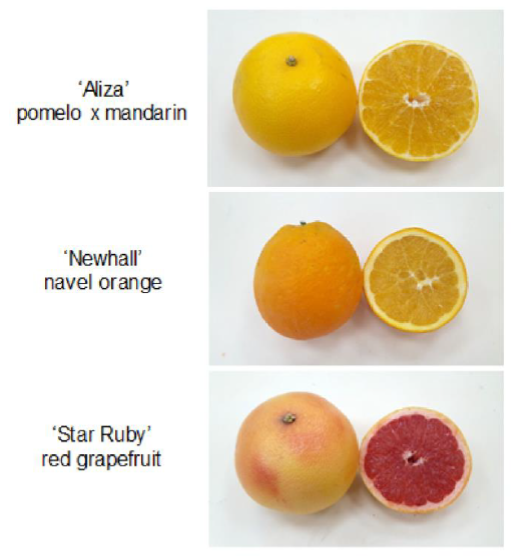
Figure 1: Pictures of fruits used in this study: 'Aliza', 'Newhall' navel orange and 'Star Ruby' red grapefruit.
2.2 TSS, acidity and juice content
Juice TSS content was measured using a PAL-1 digital refractometer (Atago, Tokyo, Japan) and TA was measured by titration to pH 8.3 with 0.1 M NaOH using an automatic titrator Model CH-9101 (Metrohm, Herisau, Switzerland). Presented data are means ± S.E. of 4 replications; each using juice collected from three different fruit, i.e. 12 fruit per measurement. Juice content was calculated as the weight of the extracted juice relative to the weight of the whole fruit. Presented data are means ± S.E. of 10 replications, each representing one whole fruit.
2.3 Descriptive sensory tests
Sensory analysis was conducted according to standard procedures [15]. Quantitative descriptive flavour analyses were performed with the aid of a trained sensory panel comprised of 10 members-four males and six females aged 25 to 65, who routinely perform flavour tests of citrus fruits as previously described [16, 17]. Each panelist assessed the various attributes of the juice samples according to an unstructured 100-mm linear intensity scale for each attribute. The scale ranged from “very weak” to “very strong” and sensory data were recorded as distances (mm) from the origin. The sensory attributes were chosen and defined by the trained panel following conduction of preliminary tasting sessions of 'Aliza' juice and open discussions of about 2-3 h each meeting. The defined flavour attributes included sweetness, sourness, bitterness, freshness, fruity citrusy aroma and fruity tropical aroma. The sensory panel was trained by tasting standards of 0-5% sucrose to evaluate sweetness, 0-0.5% citric acid to evaluate sourness and 0.5-2.5% caffeine to evaluate bitterness. Fruity citrusy aroma was related to the smell of orange peel and fruity tropical aroma was related to the smells of banana and pineapple. The trained panelists assessed the juice samples in two independence replications.
2.4 Consumer-acceptance and preference tests
Consumer flavour acceptance and preference tests were conducted according to Lawless and Heymann [15], by questioning 90 untrained panelists including employees and students working at the ARO, The Volcani Center. The panelist's age ranged between 22 to 67, but there was a relatively high representation of about two thirds of students and postdocs with ages between 22 to 35. The distribution between males and females was nearly equal. For the acceptance test, flavour scores were assigned according to a 9-point hedonic scale that ranged from “dislike extremely” to “like extremely”. For the preference test, each panelist received three cups of freshly squeezed juices: one cup of 'Aliza' juice, one cup of orange juice and one cup of red grapefruit juice. The cups were presented in a random order. The panelists were asked to report their first, second and third preferences. The results were expressed as the percentage of testers who said that a given juice was their first choice.
2.5 Electronic tongue and nose
The electrical taste profiles of the citrus juices were determined by the Taste-Sensing System SA-402B (e-tongue; Intelligent Sensor Technology Co., Kanagawa., Japan), as described previously [18]. The system included six sensors: three positively charged lipid membranes for sweetness (GL1), acidic bitterness (C00) and astringency (AE1), and three negatively charged lipid membranes for saltiness (CT0), sourness (CA0) and umami (AAE). The taste-intensity signals obtained from 70-mL juice samples were measured as the potential differences between the sample and reference solutions. Three biological replications were performed for each sample, each prepared from 3 different fruit. Taste intensities of the various attributes were calculated according to a conversion method that has been described previously [19, 20]. The electrical aroma pro?les were evaluated using an e-nose (PEN3; Airsense Analytics, Schwerin, Germany), as described recently [21]. The system consisted of a chamber with 10 metal-oxide sensors that absorb volatile compounds. The juice samples (2 mL each) were enclosed in 20-mL glass vials and allowed to stand for 30 min at room temperature, so that headspace equilibrium could be achieved. The presented data are means of two biological replications, each prepared from three different fruit; and each measurement included three repetitions, i.e. a total of six replications for each type of juice.
2.6 Data analysis
One-way analysis of variance (ANOVA) and Tukey’s HSD pairwise comparison tests were applied by means of the JMP statistical software program, version 14 (SAS Institute Inc., Cary, NC, USA). Microsoft Office Excel was used to calculate means, standard deviations, and standard errors. Principal Component Analysis (PCA) were performed with the ClustVis tool [22]. Unit variance scaling was applied to rows and Singular Value Decomposition (SVD) with imputation was used to calculate principal components by using the PCA Method R package [23].
3. Results
3.1 TSS, acidity and juice content
The TSS contents of 'Aliza', orange and grapefruit juices were 12.1, 12.7 and 11.9%, respectively, and were not significantly different from each other (Figure 2). The acidity contents of 'Aliza', orange and grapefruit juices were 1.1, 0.9 and 1.8%, respectively. As shown in Figure 2, there was no significant difference between the acidity levels of 'Aliza' juice and orange juice, but grapefruit juice was significantly more acidic than the other two citrus juices. In terms of juice content, we observed significant differences between the different species. The 'Aliza' fruits had the highest juice content of 53%, the grapefruits had a moderate juice content of 47% and the oranges had the lowest juice content of 39% (Figure 2).
3.2 Descriptive flavour profiles
The flavour profiles of 'Aliza', orange and grapefruit juices were evaluated by a trained sensory panel. Each type of juice had a different flavour profile (Figure 3). The 'Aliza' juice was characterized by high sweetness, moderate sourness and moderate bitterness taste, and strong fresh, citrusy and tropical fruity aromas. Orange juice had sweetness, sourness and freshness scores that were fairly similar to those of 'Aliza' juice, but was less bitter. It also had a stronger citrusy fruit odor, but a weaker tropical fruity odor than 'Aliza' juice. Grapefruit juice had freshness and citrusy fruity aromas similar to those of 'Aliza' juice, but was much more sour and more bitter and had less of a tropical fruity odor than 'Aliza' juice (Figure 3).
3.3 Flavour acceptance
Consumer flavour acceptance was evaluated by 90 untrained panelists according to a hedonic score on a scale ranging from 1 (“dislike extremely”) to 9 (“like extremely”). 'Aliza' juice had the highest acceptance score of 8.0, orange juice had the moderate acceptance score of 7.3 and grapefruit juice had the lowest acceptance score of 6.0 (Figure 4). All of these acceptance scores were significantly different from one another.
3.4 Flavour preferences
Flavour preferences were evaluated among 90 untrained panelists who tasted 'Aliza', orange and grapefruit juices and were asked to report their first, second and third preferences. The results revealed that a great majority (81.25%) of the tasters mostly preferred 'Aliza' juice over orange and grapefruit juices, while only 15.63% mostly preferred orange juice, and 3.12% mostly preferred grapefruit juice.
3.5 Sensory evaluations by the e-tongue and e-nose
Electrochemical sensory evaluations of 'Aliza', orange and grapefruit juices were also conducted using e-tongue and e-nose instruments. The e-tongue examinations were conducted using sensors for sweetness (GL1), sourness (CA0), bitterness (C00), saltiness (CT0), umami (AAE) and astringency (AE1). The results demonstrated the existence of significant differences in the responses of the sourness and bitterness sensors among the samples (Figure 5). Grapefruit juice was meaningfully and significantly, more sour than 'Aliza' juice, whereas orange juice was less sour than 'Aliza' juice. Grapefruit juice was also significantly more bitter than 'Aliza' juice; whereas orange juice was less bitter than 'Aliza' juice (Figure 5).
Biplot PCA based on the e-tongue data revealed that all three juices had distinct flavour profiles and that the taste of 'Aliza' juice was in the middle of the range between orange and grapefruit juices (Figure 6A). Furthermore, the results indicate that grapefruit juice was different on the PC1 axis due to its sourness and bitterness attributes, while orange juice was different on the PC1 axis due to its sweetness attribute (Figure 6A). Further biplot PCA using the electrical aroma pro?les based on data observed by the e-nose measurements revealed that the odor clusters of 'Aliza' and grapefruit juices were nearby one to another, but distinct from the aroma cluster of orange juice (Figure 6B). 'Aliza' and grapefruit juices appeared to be different on the PC1 axis by e-nose sensors 6, 8 and 10; while orange juice appeared to be different on the PC1 axis by e-nose sensors 2-5, 7 and 9 (Figure 6B).
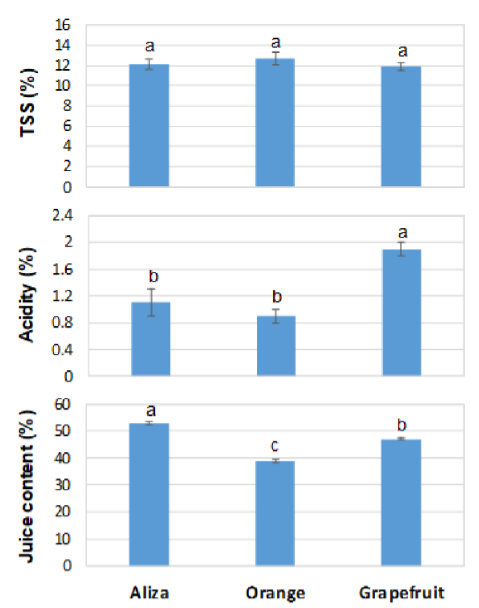
Figure 2: TSS, acidity and juice contents of 'Aliza', orange and grapefruit juices. TSS and acidity data are means of 4 replications ± S.E. Juice-content data are means of 10 replications ± S.E. Different letters indicate significant differences at p ≤ 0.05.
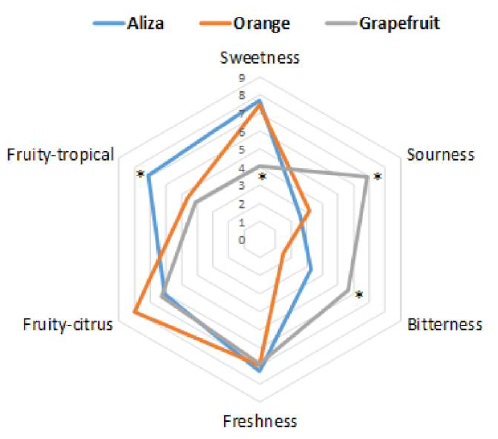
Figure 3: Flavor profiles of 'Aliza', orange and grapefruit juices. Flavor profiles were evaluated with the aid of a trained sensory panel and data are means of scores assigned by 10 testers. Asterisks indicate significant differences at p ≤ 0.01.
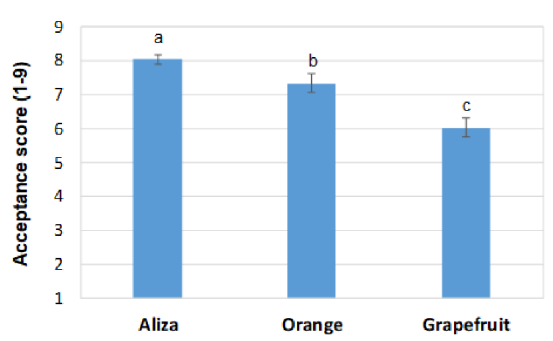
Figure 4: Consumer flavor-acceptance scores for 'Aliza', orange and grapefruit juices. Data are means ± S.E. of the ratings assigned by 90 testers. Different letters indicate significant differences at p ≤ 0.05.
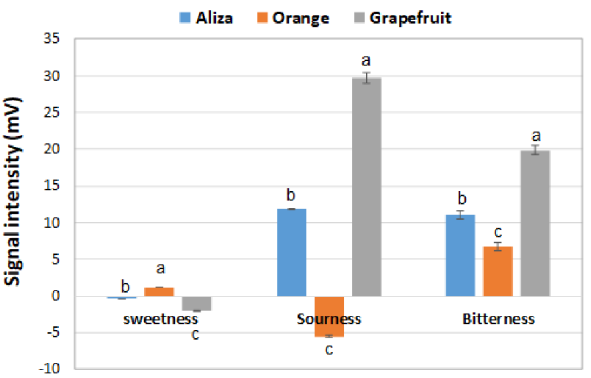
Figure 5: Taste scores of 'Aliza', orange and grapefruit juices as determined by the e-tongue. Data are means ± S.E. of 3 replications. Different letters indicate significant differences at α ≤ 0.05.
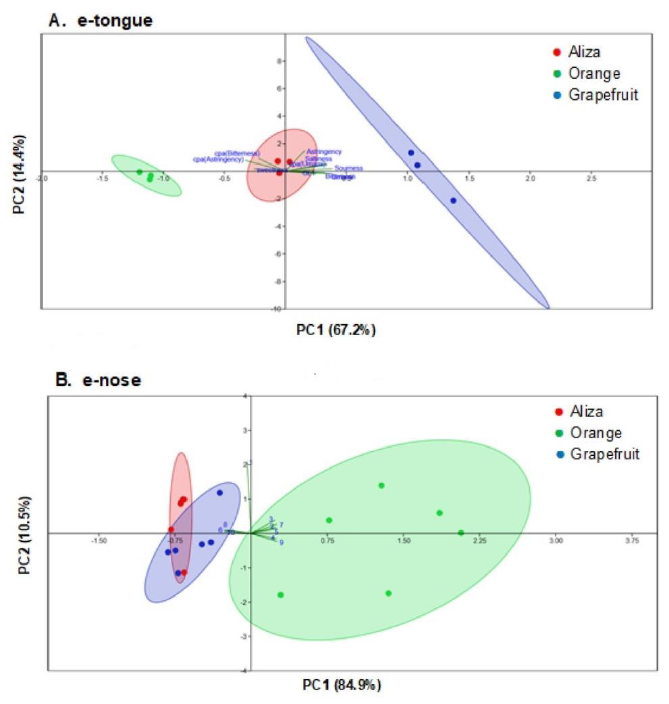
Figure 6: Biplot PCA charts of the e-tongue (A) and e-nose (B) data observed for 'Aliza', orange and grapefruit juices. Prediction ellipses are such that with probability of 0.95 a new observation from the same group will fall inside the ellipse. In Figure A, n = 9 data points, while in Figure B, n = 18 data points.
4. Discussion
Citrus juices are widely consumed worldwide due to their refreshing and exceptional flavour [1]. In this study, we characterized the sensory quality of the juice of 'Aliza', a new pomelo × mandarin hybrid with an exceptionally high juice content. Sensory analysis demonstrated that 'Aliza' juice has a distinct flavour profile, as compared to orange and grapefruit juices. Compared to orange juice, 'Aliza' juice is more bitter and has less of a citrusy odor, but more of a tropical odor. It is also less sour and bitter than red grapefruit juice, with a stronger tropical odor than grapefruit juice. Interestingly, the sensory evaluations of sourness were in accordance with the observed acidity levels, i.e. grapefruit had the highest acidity levels and was perceived as most sour. However, we have not detected any significant differences in TSS levels between the different juices, but yet the sensory panel perceived grapefruit juice as less sweet than 'Aliza' and orange juices (Figures 2-3).
The distinct sensory profile of 'Aliza' juice, as compared to orange juice and grapefruit juice, was further confirmed by objective analytical measurements conducted using an e-tongue. In this case, we found very nice correlations between the bitterness levels observed by the sensory panel and the e-tongue, both indicating that grapefruit juice was very bitter, 'Aliza' juice had moderate bitterness and oranges juice was least bitter (Figures 3, 5). Unlike the sensory panel whom indicated that grapefruit were less sweet, the e-tongue data indicated relatively similar sweetness indices. Thus, the e-tongue instrument better predicted the differences in TSS levels as compared with the sensory panel (Figures 2-3, 5). In addition, an e-nose found 'Aliza' juice to be different from orange juice but rather similar to grapefruit juice.
Our sensory evaluations further revealed that 'Aliza' juice received the highest consumer-acceptance scores among all of the examined citrus juices and was most preferred by the majority of the tasters. Nonetheless, it should be mentioned that the majority of the consumer and preference tests panelists were students and postdocs working at the Volcani Center with an average age of 22 until 35. Therefore, the achieved results might have been biased towards the preference of young people to sweet attributes while neglecting the preferences of older people to bitter attributes. Therefore, it is yet necessary to conduct further extensive consumer and preference sensory analysis among a wider group of citrus juice consumers before reaching any absolute conclusions. Also worth notice is that we compared 'Aliza' juice with only one orange variety and just one grapefruit variety, which may not represent most commercial consumed orange or grapefruit juices that are rather blends of various varieties. Furthermore, the current sensory studies were conducted using freshly squeezed non-pasteurized juices, while commercial juices are heat processed. Thus, further sensory evaluations yet need to be conducted following commercial juice manufacturing conditions before we may finally recommend on the commercial production of 'Aliza' juice.
In addition to the characterization of 'Aliza' juice, this study further demonstrates that e-tongue and e-nose provide effective means for objective evaluations of the sensory quality of citrus juices. These findings are in agreement with a previous report indicating that e-tongue may provide an effective tool for determining harvest maturity and detecting signs of citrus greening (huanglongbing) disease in orange juice [24]. In fact, e-tongue has been reported to be a very effective tool for the evaluation of sensory qualities of Chinese bayberry, pomegranate, strawberry, grape and apple juices [18, 24-28].
Overall, we demonstrated that juice from 'Aliza' fruit represents a new citrus beverage that differs in sensory quality from orange and grapefruit juices and is highly preferred by consumers due to its unique combination of sweetness and bitterness and its strong citrusy and tropical aromas.
Reference
- Hamilton A. Squeezed: What you don't know about orange juice. Yale University Press: New Haven, CT, USA (2009).
- Orange Juice. Statista (2020a).
- Grapefruit juice. Statista (2020b).
- Patil BS, Turner ND, Miller EG, et al. Potential Health Benefits of Citrus; ACS Symposium Series 936, American Chemical Society, Washington, DC, USA (2006).
- Rampersaud GC, Valim MF. 100% citrus juice: Nutritional contribution, dietary benefits, and association with anthropometric measures. Critical Reviews in Food Science and Nutrition 57 (2017): 129-140.
- Porat R, Deterre S, Giampaoli P, et al. The flavour of citrus fruit. In Eds.: Havkin-Frenkel D, Dudai N. Biotechnology in Flavour Production, 2nd, Wiley-Blackwell: Oxford, NJ, USA (2016): 1-30.
- Arena E, Guarrera N, Campisi S, et al. Comparision of odour active compounds detected by gas-chromatography-olfactometry between hand-squeezed juices from different orange varieties. Food Chemistry 98 (2006): 59-63.
- Baldwin E, Bai J, Plotto A, et al. Effect of extraction method on quality of orange juice: hand-squeezed, commercial fresh-squeezed and processed. Journal of the Science of Food and Agriculture 92 (2012): 2029-2042.
- Ramana KVR, Govindarajan VS, Raganna S. Citrus Fruits-varieties, chemistry, technology, and quality evaluation. Part I: varieties, production, handling and storage. Critical Reviews in Food Science and Nutrition 15 (1981): 383-431.
- Horowitz RM, Gentili B. Phenolic glycosides of grapefruit. A relation between bitterness and structure. Archieves in Biochemestry and Biophysics 92 (1961): 191-192.
- Buettner A, Schieberle P. Identification of the most odor-active volatiles in fresh hand-squeezed juice of grapefruit (Citrus paradisi Macfayden). Journal of Agriculture and Food Chemistry 47 (1999): 5189-5193.
- Buettner A, Schieberle P. Evaluation of key aroma compounds in hand-squeezed grapefruit juice (Citrus paradisi Macfayden) by quantitation and flavour reconstitution experiments. Journal of Agriculture and Food Chemistry 49 (2001): 1358-1363.
- Fidel L, Carmeli-Weissberg M, Yaniv Y, et al. Breeding and analysis of two new grapefruit-like varieties with low furanocoumarin content. Food and Nutrition Science 7 (2016): 90-101.
- Guttman Y, Yedidia I, Nudel A, et al. New grapefruit cultivars exhibit low cytochrome P4503A4-Inhibition activity. Food Chemical Toxicology 137 (2020): 111135.
- Lawless HT, Heymann H. Sensory Evaluation of Food. Springer Science+Buisness Media: New York, USA (2010): 14-23.
- Tietel Z, Plotto A, Fallik E, et al. Taste and aroma of fresh and stored mandarins. Journal of the Science of Food and Agriculture 91 (2011): 14-23.
- Goldenberg L, Yaniv Y, Kaplunov T, et al. Diversity in sensory quality and determining factors influencing mandarin flavour liking. J of Food Science 80 (2015): 418-425.
- Benjamin O, Gamrasni D. Electronic tongue as an objective evaluation method for taste profile of pomegranate juice in comparison with sensory panel and chemical analysis. Food Analytical Methods 9 (2016): 1726-1735.
- Legin A, Rudnitskaya A, Vlasov Y, et al. Tasting of beverages using an electronic tongue. Sensors Actuators B Chemical 44 (1997): 291-296.
- Kobayashi Y, Habara M, Ikezazki H, et al. Advanced taste sensors based on artificial lipids with global selectivity to basic taste qualities and high correlation to sensory scores. Sensors 10 (2010): 3411-3443.
- Benjamin O, Gamrasni D. Microbial, nutritional, and organoleptic quality of pomegranate juice following high-pressure homogenization and low-temperature pasteurization. Journal of Food Science 85 (2020): 592-599.
- Metsalu T, Vilo J. Clustvis: a web tool for visualizing clustering of multivariate data using Principal Component Analysis and heatmap. Nucleotide Acids Research 43 (2015): 566-570.
- Stacklies W, Redestig H, Scholz M, et al. PCA Methods-a Bioconductor package providing PCA methods for incomplete data. Bioinformatics 23 (2007): 1164-1167.
- Raithore S, Bai JH, Plotto A, et al. Electronic tongue response to chemicals in orange juice that change concentration in relation to harvest maturity and citrus greening or huanglongbing (HLB) disease. Sensors 15 (2015): 30062-30075.
- Yu H, Zhang Y, Zhao J, et al. Taste characteristics of Chinese bayberry juice characterized by sensory evaluation, chromatography analysis, and an electronic tongue. Journal of Food Science and Technology 55 (2018): 1624-1631.
- Qiu S, Wang J, Gao L. Qualification and quantification of processed strawberry juice based on electronic nose and tongue. LWT-Food Science and Technology 60 (2015): 115-123.
- Gutie?rrez-Capita?n M, Santiago JL, Vila-Planas J, et al. Classification and characterization of different white grape juices by using a hybrid electronic tongue. Journal of Agriculture and Food Chemistry 61 (2013): 9325-9332.
- Kovács Z, Sipos L, Szöllosi D, et al. Electronic tongue and sensory evaluation for sensing apple juice taste attributes. Sensor Letters 9 (2011): 1273-1281.
